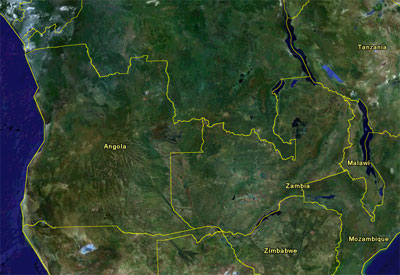ANGOLA
Please note, this page is not longer being updated. For more recent information, please see news.mongabay.com and use the search function to find the country feed. For more up-to-date data on forest cover and loss, check out Global Forest Watch.
| Angola Forest Figures
Forest Cover Total forest area: 59,104,000 ha % of land area: 47.4% Primary forest cover: n/a % of land area: 0% % total forest area: n/a Deforestation Rates, 2000-2005 Annual change in forest cover: -124,800 ha Annual deforestation rate: -0.2% Change in defor. rate since '90s: 2.1% Total forest loss since 1990: -1,872,000 ha Total forest loss since 1990:-3.1% Primary or "Old-growth" forests Annual loss of primary forests: n/a Annual deforestation rate: n/a Change in deforestation rate since '90s: n/a Primary forest loss since 1990: n/a Primary forest loss since 1990:n/a Forest Classification Public: 100% Private: 0% Other: 0% Use Production: 4% Protection: n/a Conservation: 3.2% Social services: n/a Multiple purpose: n/a None or unknown: 92.9 Forest Area Breakdown Total area: 59,104,000 ha Primary: n/a Modified natural: 58,973,000 ha Semi-natural: n/a Production plantation: 131,000 ha Production plantation: n/a Plantations Plantations, 2005: 131,000 ha % of total forest cover: 0.2% Annual change rate (00-05): -564,000 ha Carbon storage Above-ground biomass: 7,605 M t Below-ground biomass: 2,053 M t Area annually affected by Fire: n/a Insects: n/a Diseases: n/a Number of tree species in IUCN red list Number of native tree species: n/a Critically endangered: 0 Endangered: 2 Vulnerable: 19 Wood removal 2005 Industrial roundwood: 1,283,000 m3 o.b. Wood fuel: 3,913,000 m3 o.b. Value of forest products, 2005 Industrial roundwood: n/a Wood fuel: n/a Non-wood forest products (NWFPs): n/a Total Value: n/a More forest statistics for Angola |
Overall, Angola has a low deforestation rate relative to its total forest cover. Between 1990 and 2005, the country lost only 3 percent of its forests and the rate of forest conversion has kept fairly steady.
Some areas are reportedly showing the effects of land clearing, including severe soil erosion, heavy siltation of rivers and dams, and desertification.
More than 20 years of civil war have let much of Angola damaged. The government, which has hired pricey mercenaries from South Africa to put down uprisings in the resource-rich Cabinda and other areas, is heavily indebted and had sold a number of timber concessions to foreign timber companies. Oil and minerals are also important sources of revenue that could have an adverse impact on the environment.
On paper 10 percent of Angola is protected. The country has some 5,185 species of plants, 930 birds, 235 mammals, 296 reptiles, and 85 amphibians.
Suggested reading - Books
- Angola: Promises and Lies
- No One Can Stop the Rain: The Chronicles of Two Volunteers During Angola's Civil War
- Bay of Tigers: An Odyssey through War-Torn Angola
Unless otherwise specified, this article was written by Rhett A. Butler [Bibliographic citation for this page]
Other resources
Contact me if you have suggestions on other rainforest-related environmental sites and resources for this country.

Image copyright Google Earth, MDA EarthSet, DigitalGlobe 2005
CIA-World Factbook Profile
FAO-Forestry Profile
World Resources Institute
Last updated: 4 Feb 2006
